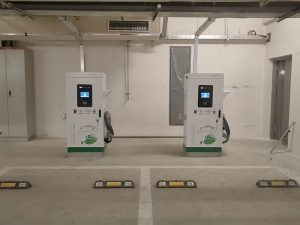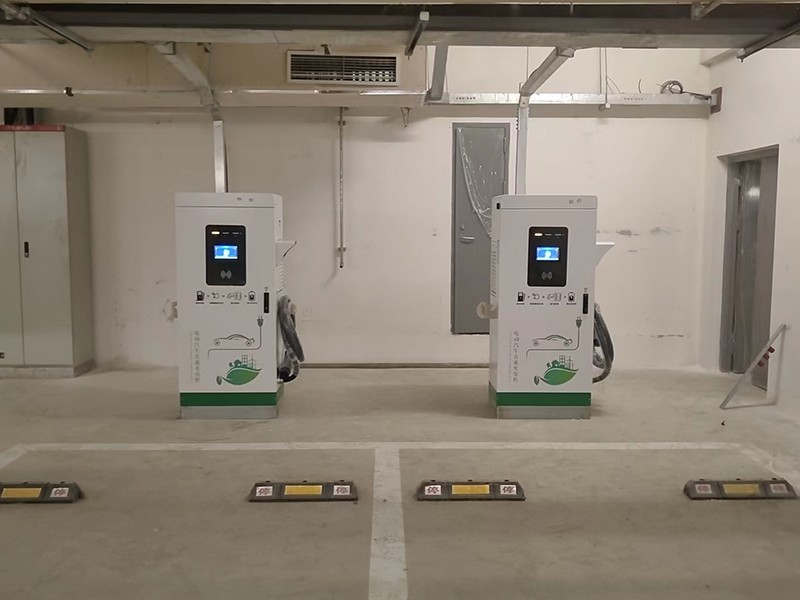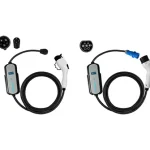Introduction
With the rising popularity of electric vehicles (EVs), more owners are looking for fast and convenient charging solutions at home. If you’ve been researching EV charging equipment, you’ve likely come across Level 1, Level 2, and Level 3 chargers. While Level 1 and Level 2 chargers are common for home use, Level 3 DC fast chargers are typically associated with public charging stations. However, did you know that, in certain cases, Level 3 DC fast chargers can also be installed at home? This article dives deep into the definition, benefits, installation feasibility, and comparison with Level 2 chargers to help you decide if this ultra-fast charging solution is right for you.

What is a Level 3 DC Fast Charger?
EV charging is categorized into three levels, each with different charging speeds and power outputs:
-
Level 1 Charging: Uses 120V AC power, delivering about 1-2kW. It’s extremely slow, often taking days to fully charge an EV.
-
Level 2 Charging: Uses 240V AC power, with outputs ranging from 6-19kW. It’s the standard for home charging, capable of fully charging a mid-sized EV battery overnight.
-
Level 3 Charging: Also known as DC fast charging, it uses 400V or 800V DC power, with outputs ranging from 25kW to 360kW, making it the fastest charging option available.
Level 3 chargers deliver direct current (DC) to the EV’s battery, significantly reducing charging time. For example, a 25kW charger can charge a 24kWh Nissan Leaf from 0% to 80% in about 40 minutes, while higher-powered chargers (50kW-350kW) can add 100-300 miles of range in 15-30 minutes EVBox: Level 3 Charging.
Due to their high power requirements, Level 3 chargers are typically installed in commercial locations like gas stations, highway rest stops, or public parking lots. However, certain lower-power Level 3 chargers (e.g., 25kW) are marketed as suitable for residential use, opening the door to fast charging at home.
Why Consider a Level 3 Charger for Home?
A Level 3 DC fast charger at home may appeal to EV owners in the following scenarios:
-
Multiple EVs: If your household owns multiple electric vehicles, fast charging can reduce wait times.
-
Large Battery Capacities: Some EVs, like the Tesla Model S or Rivian R1T, have large batteries that take longer to charge with Level 2 chargers. A Level 3 charger can significantly cut charging time.
-
Frequent Travel: If you need quick charging to support frequent short or long trips, a home Level 3 charger offers the convenience of a public charging station.
-
Future-Proofing: As EV technology advances, more models may support fast charging, making a Level 3 charger a forward-thinking investment.
For instance, a 25kW Level 3 charger can add about 100 miles of range to a Nissan Leaf in 40 minutes, while a Level 2 charger might take 4-6 hours EV Charge Solutions: Delta Wallbox. For households with high charging demands, a Level 3 charger is a powerful option.
Feasibility of Installing a Level 3 Charger at Home
While a Level 3 DC fast charger is technically feasible for home use, its installation comes with challenges. Here are the key factors to consider:
Power Requirements
Level 3 chargers typically require high voltage (400V or 800V) and three-phase power, whereas most homes have single-phase 240V power. This means installing a Level 3 charger may require:
-
Upgrading your home’s electrical system, including installing a new distribution panel and wiring.
-
In some cases, arranging for three-phase power or a transformer from your utility provider. These upgrades can be complex and costly, depending on your home’s existing electrical infrastructure Car and Driver: Best Home EV Chargers.
Cost
The cost of a home Level 3 charger includes both equipment and installation:
-
Equipment Cost: Lower-power Level 3 chargers, like the Delta Wallbox DCFC 25kW, start at around $975, while higher-powered models can cost thousands.
-
Installation Cost: Electrical upgrades and installation can range from $1,000 to $10,000, depending on the complexity of your home’s electrical system. In contrast, Level 2 chargers typically cost $500-$2,000 for equipment, with lower installation costs since many homes already have 240V power.
Regulations and Permits
Installing a Level 3 charger at home may require:
-
Building permits from your local government to ensure compliance with safety standards.
-
Approval from your utility provider, especially if three-phase power or a transformer upgrade is needed.
-
Inspection and certification by a licensed electrician to ensure the system operates safely. These requirements vary by region, so consult your local government and a professional electrician before proceeding.
Practicality
For most EV owners, a Level 2 charger is sufficient for daily needs. For example, a Level 2 charger can add 25-50 miles of range per hour, making it ideal for overnight charging. While Level 3 chargers offer ultra-fast charging, they may not be necessary for home use unless you have specific needs, such as multiple EVs or large battery capacities.
Level 2 vs. Level 3 Chargers: A Comparison
To help you decide whether a Level 3 DC fast charger is right for your home, here’s a detailed comparison with Level 2 chargers:
|
Feature |
Level 2 Charger |
Level 3 Charger |
|---|---|---|
|
Power Output |
6-19kW |
25kW-360kW |
|
Charging Speed |
Adds 25-50 miles of range per hour |
Adds 100-300 miles in 15-30 minutes |
|
Equipment Cost |
$500-$2,000 |
$975 and up (low-power models) |
|
Installation Cost |
Typically hundreds of dollars (if 240V power is available) |
$1,000-$10,000 (requires electrical upgrades) |
|
Power Requirements |
Single-phase 240V, common in homes |
Three-phase power, requires upgrades |
|
Use Case |
Homes, offices, public parking |
Commercial sites, high-demand homes |
Speed
Level 2 chargers are ideal for overnight charging, typically fully charging a 300-mile-range EV in 6-8 hours. Level 3 chargers are much faster, with a 25kW model charging a small battery in 40 minutes and higher-powered models (50kW+) completing most charging in 15 minutes EVBox: Level 3 Charging Speed.
Cost
Level 2 chargers are far more affordable in terms of both equipment and installation costs. For budget-conscious households, they’re the more economical choice.
Installation
Level 2 charger installation is straightforward, often requiring only a 240V outlet, which many homes already have. Level 3 chargers may necessitate extensive electrical upgrades, increasing complexity and cost.
Applicability
Level 2 chargers are the standard for home charging, suitable for most EV owners. Level 3 chargers are better suited for commercial use or homes with unique needs, such as multiple EVs or a need for rapid charging.
Level 3 Charger Products Suitable for Home Use
While Level 3 chargers are uncommon in homes, some products are marketed as suitable for residential use. Here’s an example:
Delta Wallbox DCFC 25kW
-
Power Output: 25kW (low end of Level 3 charging).
-
Charging Speed: Can charge a 24kWh Nissan Leaf battery from 0% to 80% in about 40 minutes.
-
Connector Type: SAE Combo charging connector.
-
Features: Modular design, supports RFID and mobile app access.
-
Use Case: EV parking lots, fleet charging, residential.
-
Price: $975, relatively affordable for a Level 3 charger.
-
Source: EV Charge Solutions: Delta Wallbox.
Other high-power Level 3 chargers, like the Autel MaxiCharger DC Fast 60kW-240kW, are typically designed for commercial use and may not be suitable for home installation Autel Energy: MaxiCharger.
Conclusion
A Level 3 DC fast charger at home offers the potential for ultra-fast EV charging, but its high cost and complex power requirements make it impractical for most households. Products like the Delta Wallbox DCFC 25kW demonstrate that home Level 3 chargers are technically feasible, but you’ll need to carefully assess your electrical system and budget. For most EV owners, a Level 2 charger is the more practical and cost-effective choice, meeting daily charging needs with ease. If you have multiple EVs or require rapid charging, a Level 3 charger may be worth considering, but consult a professional electrician to ensure safe and feasible installation.
Before deciding, we recommend:
-
Discussing your home’s electrical system with a professional electrician to determine if it can support a Level 3 charger.
-
Comparing the long-term costs and benefits of Level 2 and Level 3 chargers.
-
Checking for local subsidies or incentives for EV charging equipment.
With careful planning, you can choose the best charging solution for your EV, ensuring a convenient and efficient charging experience.


